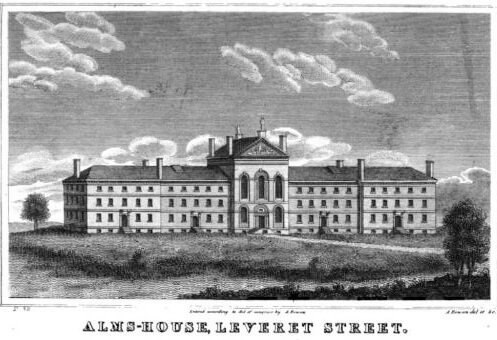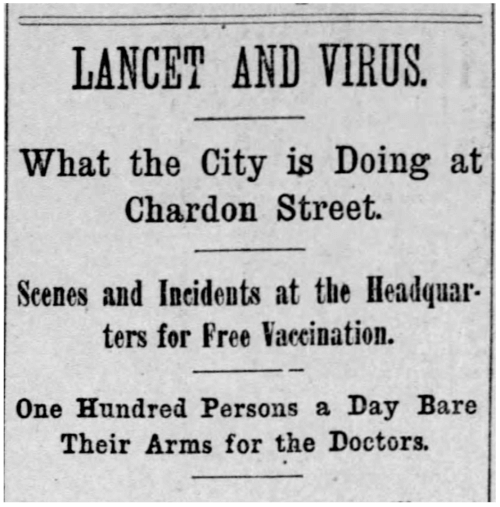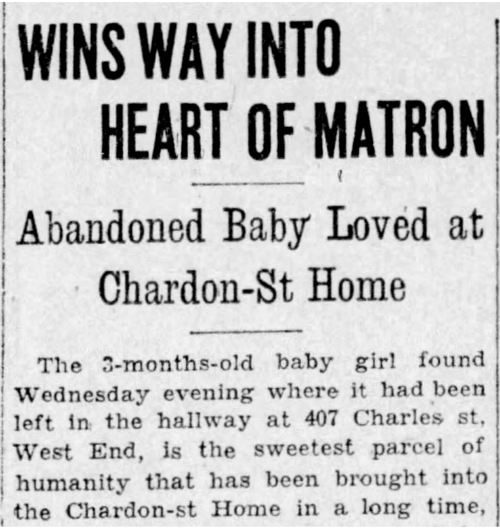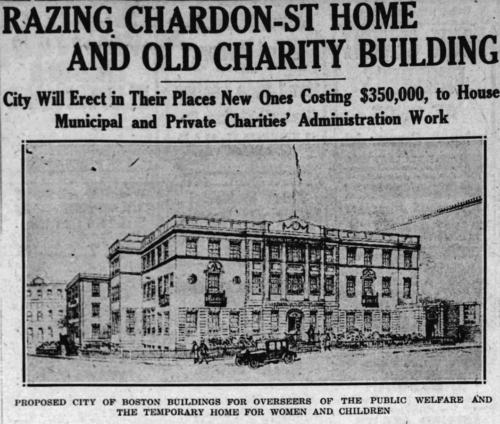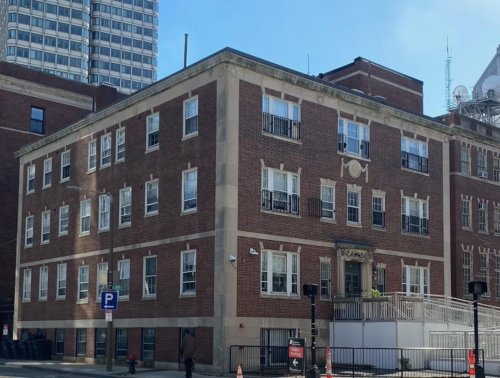The Temporary Home for Women and Children
The Temporary Home for Women and Children located on New Chardon Street in Boston’s West End was one of the first family shelters in the country. From its start as a small home on Charles Street, it has cared for women and children in need for over 150 years.
From 1630 to 1692, poor relief was the direct responsibility of Boston’s Town Selectmen. In 1692 a colonial act shifted the responsibility to a board of four Overseers of the Poor. The Overseers of the Poor were appointed by the Selectmen until 1708, after which they were chosen through the Town Meeting. In 1713 the board was expanded to eight Overseers, one for each ward. As the number of Boston wards increased to twelve, so did the number of Overseers. Many of the Overseers were among Boston’s wealthiest residents and served for multiple decades. They regularly patrolled their wards and had the direct authority to send individuals to the almshouse or the workhouse.
The Boston almshouse was on Beacon Street until 1801, on Leverett Street until 1825, and later moved to Deer Island. Larger state almshouses in Bridgewater and Tewksbury opened in 1854. Almshouses provided relief in the form of food, fuel, medicines, and sometimes money to the needy of their wards. Those who were not settled in Boston were provided relief at the expense of their home town until they chose to leave the city or they were removed to a state almshouse. The city’s workhouse, or House of Industry for “able bodied paupers and convicts”, was located on First Street in South Boston until it too moved to Deer Island in 1853.
The influx of recent arrivals to Boston, primarily from Ireland, created a constant need for more shelter space. The Overseers opened a temporary shelter in 1857 at the City Crier’s house on Portland Street, primarily to house those waiting to be sent to Deer Island. As the shelter began taking in more women and children, it moved to 36 Charles Street, which in turn soon became overcrowded. Diseases, such as tuberculosis, cholera, and others were rampant in this period, killing sixteen of the home’s children in 1864 alone.
The Overseers built a new, larger shelter in 1869 at the intersection of Chardon, Hawkins, and Bowker Streets in the West End. Named the Charity Building, the primary function of this facility was to serve as the Temporary Home for Women and Children. Here workers could provide food, shelter, and healthcare (including vaccinations) for up to 100 women and children. They also arranged employment for the adult women. Intake records described the case of each woman and her reason for seeking help. They tell stories of both “native” Bostonians and recent immigrants who were widowed, deserted, evicted, and abused. To understand the need, in one year (1884-1985) the Temporary Home took in over 4,200 women and over 800 children.
The Home also took in abandoned children, many of them newborns found on doorsteps and brought in by a police officer or one of the Overseers. These unknown babies were usually given a last name of the street where they were found. Their approximate age and health status were recorded and attempts were made to locate their parent or family members. For those unclaimed, the Home would attempt to arrange adoptions, using its matrons to verify the qualifications of potential adopting families. Sadly, many adopted children were returned to the Home after being “found to be diseased”. Children with chronic illnesses were classified as “unfit for adoption” and transferred to the almshouse in Tewksbury or Bridgewater. Babies and children sent to an almshouse had little chance for a healthy life.
The Charity Building also offered meals to men in need and later the city opened The Wayfarer’s Lodge for men at the same site. An 1879 newspaper article described the lodge.
Lodgers are supplied with plain, well-cooked food, but in order that the self-respect of the most sensitive may not be wounded, all are required to work for what they receive. So far as possible the labor of the applicants is utilized in the direction of their peculiar qualifications. Every lodger is required to cut one-eighth of a cord of wood in payment for lodging and breakfast — the wood being sold under contract, and the expenses of the “Lodge” being thus in part reimbursed.
In 1921, the Overseers of the Poor became the Overseers of Public Welfare and funds were raised to replace the original 1869 Charity Building and Temporary Home for Women and Children. Eventually the original building was demolished and Its replacement opened in 1926. The new facility came complete with a modern kitchen and a rooftop playground. Its expanded capacity allowed the Home to keep abandoned babies for a longer period, while reports ran in the newspaper in hopes of finding a relative or adoptive family. During the Great Depression, the Home became a key site as an emergency shelter and health clinic.
Today the Temporary Home for Women and Children continues to operate in the same building on the renamed New Chardon Street. Managed by the Massachusetts Department of Social Services, it was renovated in 1998, and survived severe budget cuts in 2001. It was able to increase its capacity in 2021, and offers advocacy, counseling, medical care, meals, and housing for women and their children in need.
Article by Janelle Fisher Smart, edited by Bob Potenza
Sources: Boston Overseers of the Poor Records, 1733-1925;
Boston Globe: June 12, 1885; September 9, 1885;August 27, 1888; March 26, 1914; September 19, 1924; April 30, 1927;January 26, 1925; April 26, 1969; City of Boston Archives; Massachusetts Historical Society; disabilitymuseum.org.



